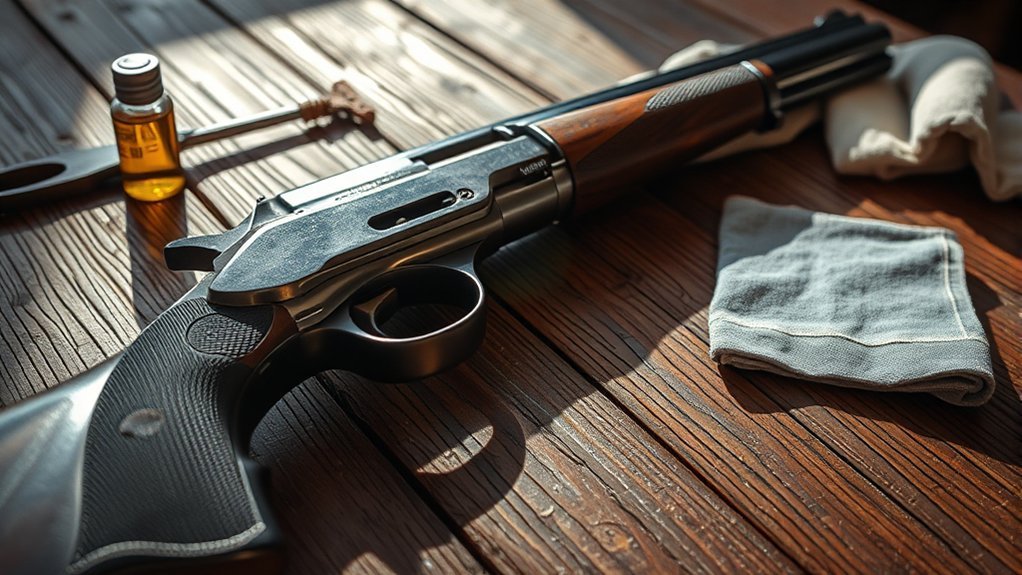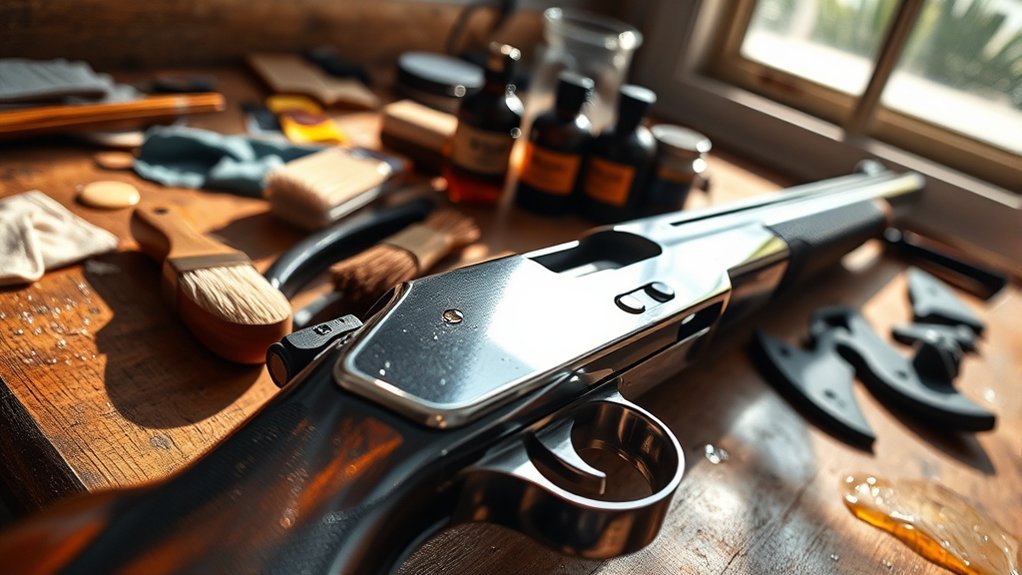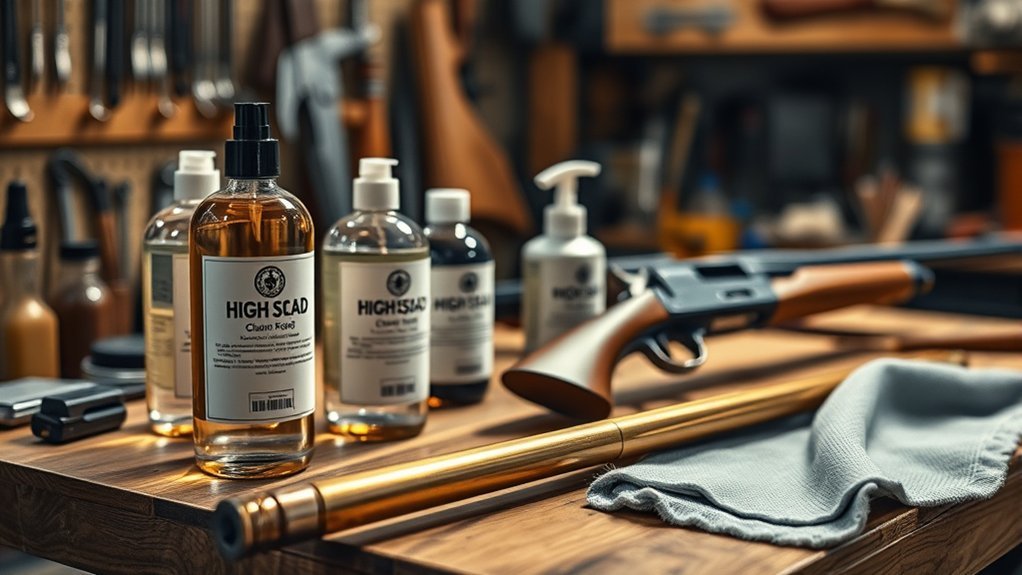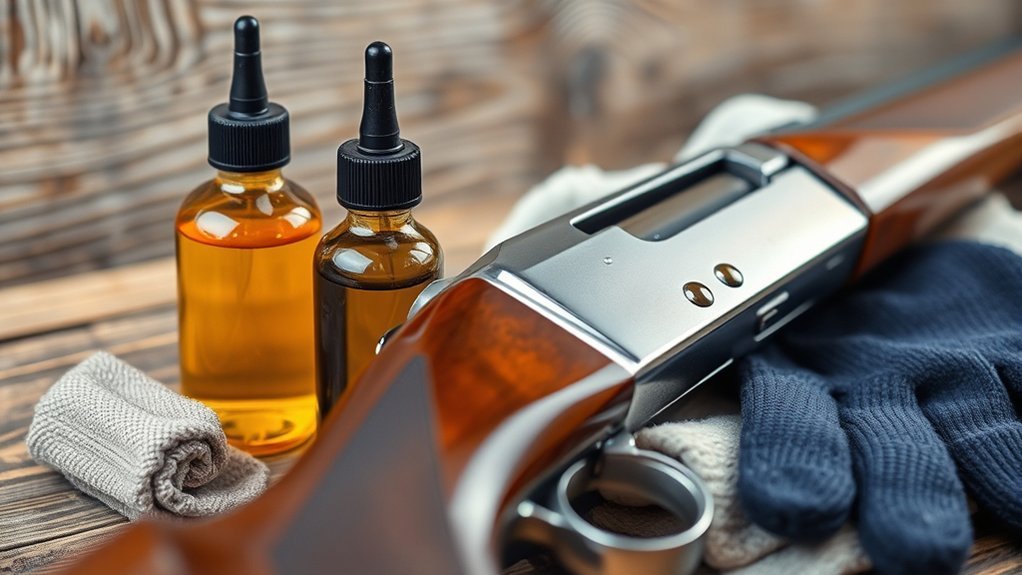When it comes to firearms, maintaining their pristine condition is essential for peak performance. Rust can be a silent adversary, slowly compromising your investment if not addressed. To effectively combat this issue, you’ll need to understand the fundamentals of rust prevention. From proper cleaning techniques to selecting the right storage environment, there are several strategies that can safeguard your firearms. Let’s explore the key practices that can make a significant difference.
Understanding Rust and Its Causes

Rust, a common enemy of firearms, forms through a chemical reaction known as oxidation. This process occurs when iron or its alloys react with moisture and oxygen in the environment. You might notice rust developing under conditions of high humidity or in the presence of salt, which accelerates the oxidation process. Additionally, contaminants like dirt and oil can create localized areas of corrosion if not properly managed. When firearms are stored in poorly ventilated areas or left unprotected after use, the risk of rust increases considerably. Understanding these factors is essential for maintaining your firearm’s integrity. By recognizing how rust forms, you can take proactive steps to prevent it and guarantee your firearm remains in ideal condition.
Importance of Regular Cleaning

While you might think that a firearm only needs cleaning after extensive use, regular maintenance is essential to preventing rust and ensuring peak performance. Neglecting this important task can lead to corrosion and malfunctions. Here’s why you should prioritize regular cleaning:
- Moisture Removal: Regular cleaning eliminates moisture that can cause rust.
- Debris Elimination: It removes dirt and fouling that can impair function.
- Lubrication Maintenance: Routine cleaning allows you to check and maintain proper lubrication, critical for smooth operation.
- Longevity Assurance: Consistent care extends your firearm’s life, saving you money in the long run.
Choosing the Right Cleaning Products

When it comes to maintaining your firearms, selecting the right cleaning products is vital. You’ll need to understand the various types of cleaning solvents that effectively remove carbon, lead, and moisture, as well as the essential cleaning tools that help you perform the job efficiently. Making informed choices here can markedly enhance your firearm’s longevity and performance.
Types of Cleaning Solvents
Choosing the right cleaning solvent for your firearms is essential to guarantee effective maintenance and rust prevention. Here are four types of cleaning solvents you should consider:
- Solvent-based cleaners: These are powerful and effective for removing carbon and lead buildup but can be harsh; use them with caution.
- Water-based cleaners: These are less toxic and easier to clean up, making them a safer choice for general maintenance.
- CLP (Clean, Lubricate, Protect): This all-in-one product simplifies cleaning by combining cleaning, lubrication, and corrosion protection in one solution.
- Bio-based cleaners: Environmentally friendly, these solvents offer a safer alternative without compromising cleaning effectiveness.
Selecting the right solvent guarantees your firearms are well-maintained and protected against rust.
Essential Cleaning Tools
Selecting the right cleaning tools is crucial for maintaining the performance and longevity of your firearms. Using the appropriate products guarantees effective cleaning and rust prevention. Here’s a quick reference table to help you choose:
| Tool Type | Purpose | Recommended Brands |
|---|---|---|
| Cleaning Rod | Pushes patches through barrel | Tipton, Dewey |
| Brushes | Scrubs fouling from surfaces | Hoppes, Otis |
| Patches | Absorbs solvent, cleans barrel | Pro-Shot, Tipton |
| Lubricants | Protects against rust and wear | CLP, Break-Free |
Invest in high-quality tools to simplify your cleaning process and enhance the lifespan of your firearms. Regular maintenance with the right tools is crucial for ideal functionality.
Proper Storage Techniques
While proper storage techniques may seem straightforward, they play an essential role in preventing rust on your firearms. To guarantee your firearms remain rust-free, follow these key storage practices:
- Choose a Climate-Controlled Environment: Store firearms in a cool, dry place to minimize humidity.
- Use Gun Cases or Safes: Protect your firearms from dust and moisture by keeping them in quality cases or safes.
- Avoid Direct Contact with Metal: Use silicone gun socks or padded cases to prevent metal-on-metal contact, which can lead to scratches and rust.
- Regularly Inspect and Rotate: Periodically check your firearms for signs of rust and rotate their positions to guarantee even air circulation.
Applying Protective Coatings
To protect your firearms from rust, applying the right protective coatings is crucial. You’ll need to understand the various types available, the proper application techniques, and how to maintain these coatings effectively. This knowledge will guarantee your firearms remain in prime condition and resistant to corrosion.
Types of Protective Coatings
When it comes to protecting your firearms from rust, understanding the various types of protective coatings is essential. Each coating offers unique benefits tailored to different needs. Here are four common types you’ll encounter:
- Bluing: A traditional method that forms a protective layer through oxidation, providing moderate rust resistance.
- Parkerizing: A phosphate-based finish that provides excellent corrosion resistance, often used in military firearms.
- Cerakote: A modern ceramic-based coating that offers exceptional durability and can withstand extreme conditions.
- Oil: A simple and effective option, oil coatings provide temporary protection but require regular reapplication.
Choosing the right coating will considerably enhance your firearm’s longevity and performance in adverse conditions.
Application Techniques Overview
Applying protective coatings to firearms requires precision and attention to detail to secure peak performance and longevity. First, thoroughly clean your firearm to remove dirt, oil, and existing rust. Use a degreaser or solvent for this step. Once clean, dry the surface completely. For spray applications, hold the can about 6-12 inches away and apply in light, even coats to avoid drips. If you’re using a brush, choose high-quality bristles for a smooth finish. Be mindful of temperature and humidity, as these factors can affect adhesion. Allow each coat to dry fully before applying subsequent layers, generally at least 24 hours. Finally, cure the coating as recommended by the manufacturer to guarantee maximum durability and effectiveness.
Maintenance and Care Tips
Regular maintenance and care are essential for preserving the effectiveness of protective coatings on firearms. To guarantee your firearm remains rust-free, follow these maintenance tips:
- Clean Regularly: Remove dirt, moisture, and residues after each use. Use a suitable cleaning solvent and cloth.
- Inspect Coatings: Routinely check for any wear or damage to the protective coating. Address issues immediately to prevent rust.
- Apply Protective Oils: Use high-quality gun oils or waxes explicitly designed for firearms. Reapply them according to the manufacturer’s recommendations.
- Store Properly: Keep your firearm in a climate-controlled environment, away from humidity. Utilize silicone gun socks or desiccants for extra protection.
Implementing these practices will greatly enhance the longevity of your firearm’s protective coatings.
Environmental Considerations
While rust can develop on firearms due to various environmental factors, understanding these considerations is essential for effective prevention. Humidity is a primary concern; high moisture levels can accelerate corrosion. Store your firearms in a climate-controlled environment to mitigate this risk. Temperature fluctuations can also lead to condensation, fostering rust. Avoid storing firearms in damp basements or garages. Additionally, exposure to saltwater or corrosive elements can rapidly degrade metal surfaces. If you live near the coast, consider using protective coatings or silicone-treated gun cases. Regularly check your storage area for signs of moisture or contaminants. By being mindful of these environmental factors, you can greatly reduce the risk of rust and prolong the life of your firearms.
Routine Inspections and Maintenance
Routine inspections and maintenance are essential for guaranteeing your firearms remain in ideal condition and free from rust. By regularly checking your firearms, you can catch potential issues before they worsen. Follow these steps for effective maintenance:
- Visual Inspection: Check for any signs of rust, corrosion, or damage on the surface and internal components.
- Cleaning: Use appropriate cleaning products to remove dirt, debris, and moisture, especially from the bore and action.
- Lubrication: Apply a high-quality gun oil to moving parts and any surfaces that may come into contact with moisture.
- Storage Check: Guarantee your storage environment is controlled for humidity and temperature to minimize rust risk.
Conclusion
By embracing these rust prevention practices, you’re not just safeguarding your firearms; you’re ensuring they remain reliable companions for years to come. Regular cleaning, appropriate storage, and protective coatings all play an essential role in preserving their integrity. Remember, a little attention today can prevent a more significant issue tomorrow. So, take pride in your upkeep routine, and let your firearms shine without the worry of corrosion lurking in the shadows. Your investment deserves it.

